Comprehensive Financial Analysis: Browns Plc Case Study Report
VerifiedAdded on 2023/06/18
|13
|3500
|445
Case Study
AI Summary
This case study provides a financial analysis of Browns Plc, focusing on ratio analysis, cash flow, and working capital management. The analysis includes calculations and interpretations of key financial ratios such as Gross Profit Margin, Operating Profit Margin, Current Ratio, Quick Ratio, Inventory Holding Period, and Payables Payment Period, comparing the results between 2018 and 2019. The irrelevance of computing the receivables collection period is justified due to the company's cash-based operational practices. Furthermore, the report differentiates between profit and cash flow, explains the components of working capital (receivables, inventory, and payables) along with their advantages and disadvantages, and analyzes the impact of changes in working capital on cash flow. The study concludes with an analysis of the appropriateness of traditional and alternative budgetary systems in the given context. Desklib offers a variety of solved assignments and study resources for students.

FINANCIAL
MANAGEMENT
MANAGEMENT
Paraphrase This Document
Need a fresh take? Get an instant paraphrase of this document with our AI Paraphraser
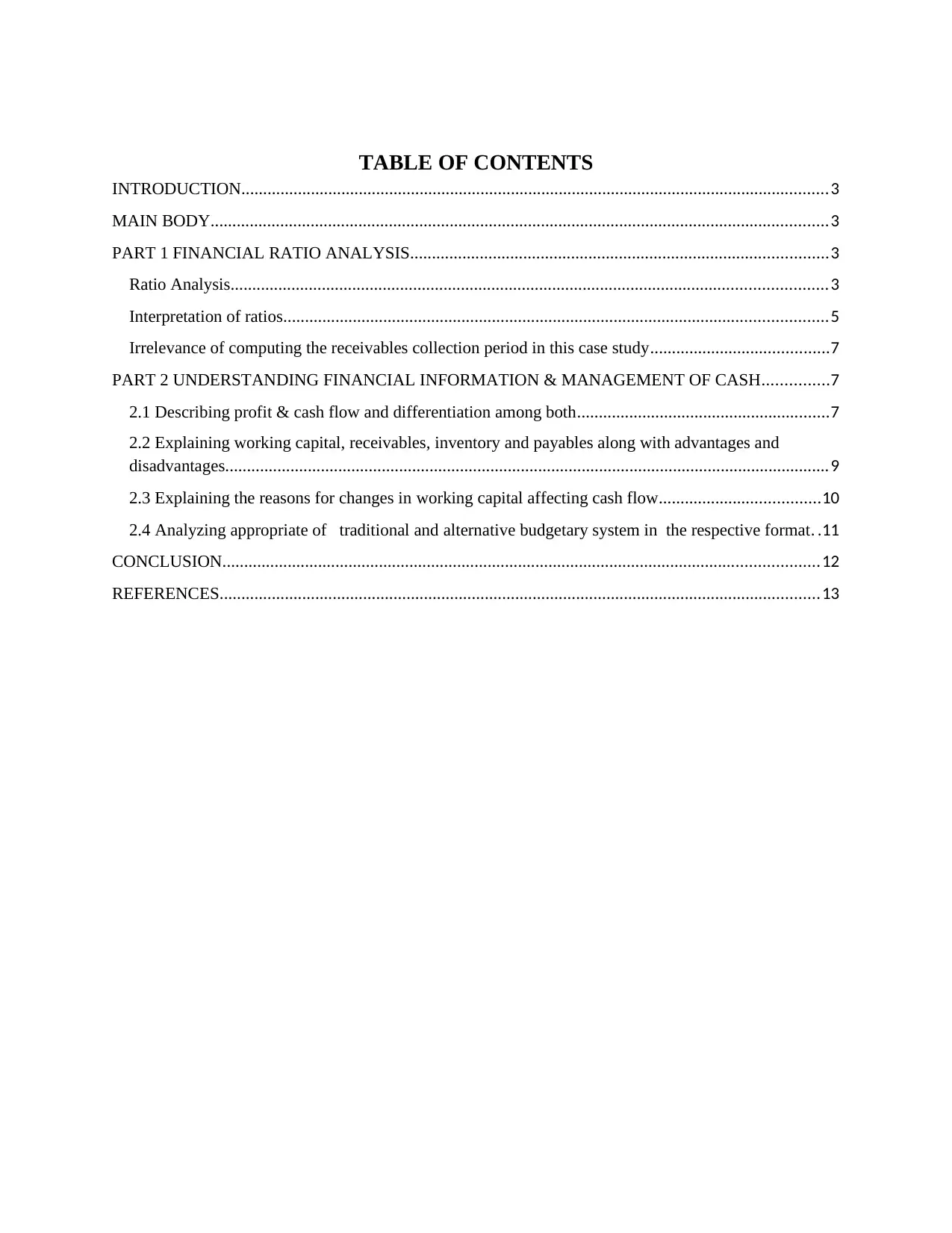
TABLE OF CONTENTS
INTRODUCTION.......................................................................................................................................3
MAIN BODY..............................................................................................................................................3
PART 1 FINANCIAL RATIO ANALYSIS................................................................................................3
Ratio Analysis.........................................................................................................................................3
Interpretation of ratios.............................................................................................................................5
Irrelevance of computing the receivables collection period in this case study.........................................7
PART 2 UNDERSTANDING FINANCIAL INFORMATION & MANAGEMENT OF CASH...............7
2.1 Describing profit & cash flow and differentiation among both..........................................................7
2.2 Explaining working capital, receivables, inventory and payables along with advantages and
disadvantages...........................................................................................................................................9
2.3 Explaining the reasons for changes in working capital affecting cash flow.....................................10
2.4 Analyzing appropriate of traditional and alternative budgetary system in the respective format. .11
CONCLUSION.........................................................................................................................................12
REFERENCES..........................................................................................................................................13
INTRODUCTION.......................................................................................................................................3
MAIN BODY..............................................................................................................................................3
PART 1 FINANCIAL RATIO ANALYSIS................................................................................................3
Ratio Analysis.........................................................................................................................................3
Interpretation of ratios.............................................................................................................................5
Irrelevance of computing the receivables collection period in this case study.........................................7
PART 2 UNDERSTANDING FINANCIAL INFORMATION & MANAGEMENT OF CASH...............7
2.1 Describing profit & cash flow and differentiation among both..........................................................7
2.2 Explaining working capital, receivables, inventory and payables along with advantages and
disadvantages...........................................................................................................................................9
2.3 Explaining the reasons for changes in working capital affecting cash flow.....................................10
2.4 Analyzing appropriate of traditional and alternative budgetary system in the respective format. .11
CONCLUSION.........................................................................................................................................12
REFERENCES..........................................................................................................................................13
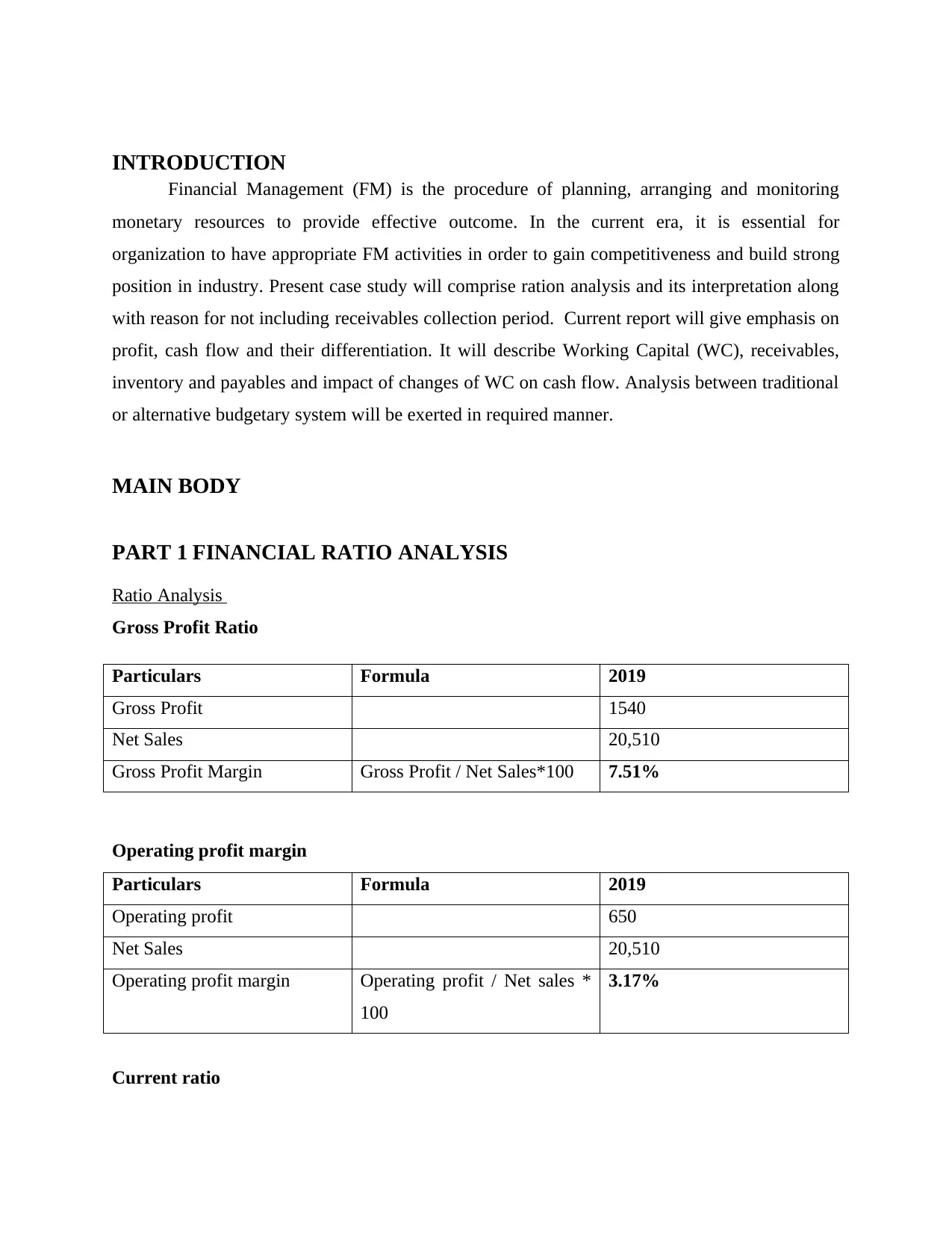
INTRODUCTION
Financial Management (FM) is the procedure of planning, arranging and monitoring
monetary resources to provide effective outcome. In the current era, it is essential for
organization to have appropriate FM activities in order to gain competitiveness and build strong
position in industry. Present case study will comprise ration analysis and its interpretation along
with reason for not including receivables collection period. Current report will give emphasis on
profit, cash flow and their differentiation. It will describe Working Capital (WC), receivables,
inventory and payables and impact of changes of WC on cash flow. Analysis between traditional
or alternative budgetary system will be exerted in required manner.
MAIN BODY
PART 1 FINANCIAL RATIO ANALYSIS
Ratio Analysis
Gross Profit Ratio
Particulars Formula 2019
Gross Profit 1540
Net Sales 20,510
Gross Profit Margin Gross Profit / Net Sales*100 7.51%
Operating profit margin
Particulars Formula 2019
Operating profit 650
Net Sales 20,510
Operating profit margin Operating profit / Net sales *
100
3.17%
Current ratio
Financial Management (FM) is the procedure of planning, arranging and monitoring
monetary resources to provide effective outcome. In the current era, it is essential for
organization to have appropriate FM activities in order to gain competitiveness and build strong
position in industry. Present case study will comprise ration analysis and its interpretation along
with reason for not including receivables collection period. Current report will give emphasis on
profit, cash flow and their differentiation. It will describe Working Capital (WC), receivables,
inventory and payables and impact of changes of WC on cash flow. Analysis between traditional
or alternative budgetary system will be exerted in required manner.
MAIN BODY
PART 1 FINANCIAL RATIO ANALYSIS
Ratio Analysis
Gross Profit Ratio
Particulars Formula 2019
Gross Profit 1540
Net Sales 20,510
Gross Profit Margin Gross Profit / Net Sales*100 7.51%
Operating profit margin
Particulars Formula 2019
Operating profit 650
Net Sales 20,510
Operating profit margin Operating profit / Net sales *
100
3.17%
Current ratio
⊘ This is a preview!⊘
Do you want full access?
Subscribe today to unlock all pages.

Trusted by 1+ million students worldwide
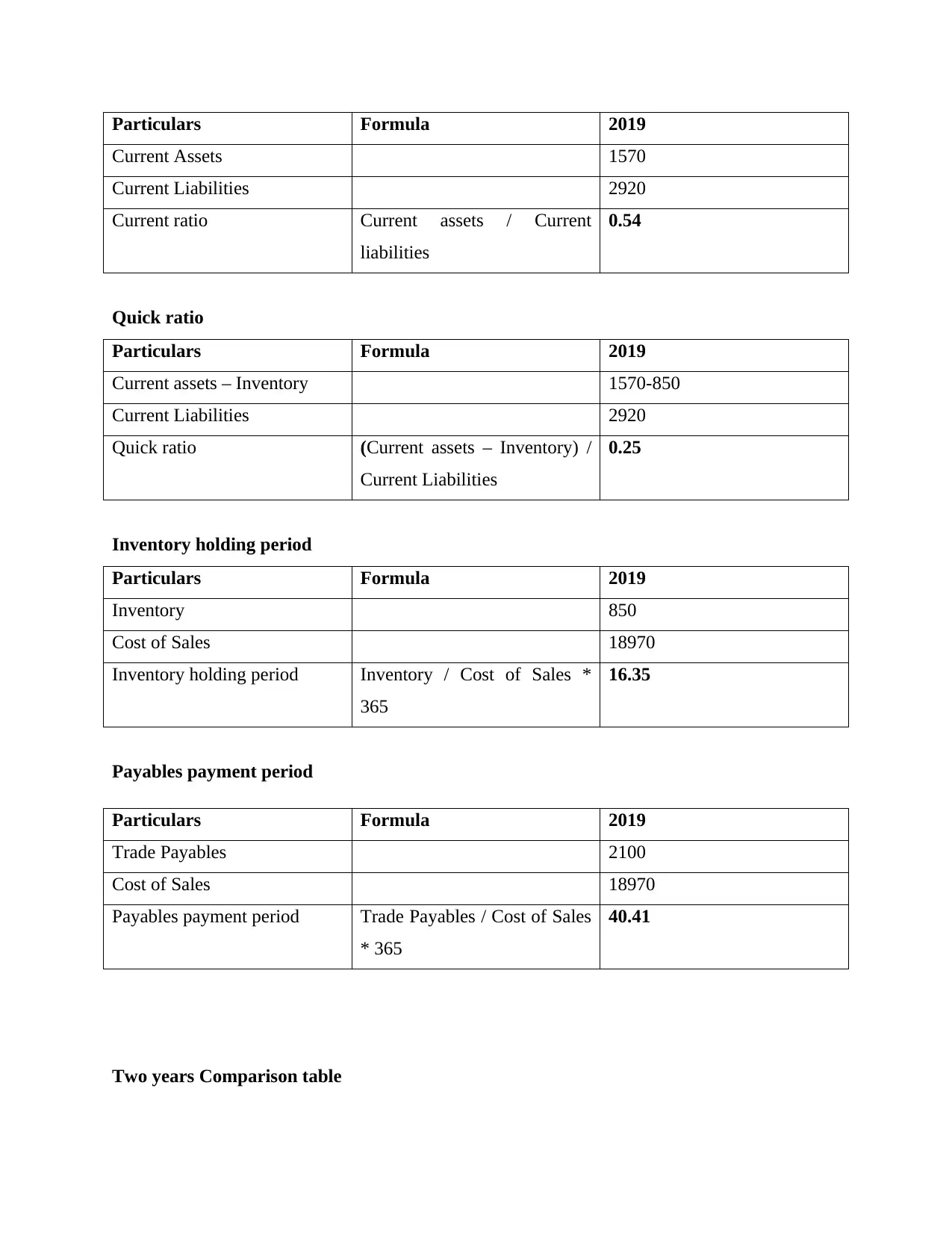
Particulars Formula 2019
Current Assets 1570
Current Liabilities 2920
Current ratio Current assets / Current
liabilities
0.54
Quick ratio
Particulars Formula 2019
Current assets – Inventory 1570-850
Current Liabilities 2920
Quick ratio (Current assets – Inventory) /
Current Liabilities
0.25
Inventory holding period
Particulars Formula 2019
Inventory 850
Cost of Sales 18970
Inventory holding period Inventory / Cost of Sales *
365
16.35
Payables payment period
Particulars Formula 2019
Trade Payables 2100
Cost of Sales 18970
Payables payment period Trade Payables / Cost of Sales
* 365
40.41
Two years Comparison table
Current Assets 1570
Current Liabilities 2920
Current ratio Current assets / Current
liabilities
0.54
Quick ratio
Particulars Formula 2019
Current assets – Inventory 1570-850
Current Liabilities 2920
Quick ratio (Current assets – Inventory) /
Current Liabilities
0.25
Inventory holding period
Particulars Formula 2019
Inventory 850
Cost of Sales 18970
Inventory holding period Inventory / Cost of Sales *
365
16.35
Payables payment period
Particulars Formula 2019
Trade Payables 2100
Cost of Sales 18970
Payables payment period Trade Payables / Cost of Sales
* 365
40.41
Two years Comparison table
Paraphrase This Document
Need a fresh take? Get an instant paraphrase of this document with our AI Paraphraser
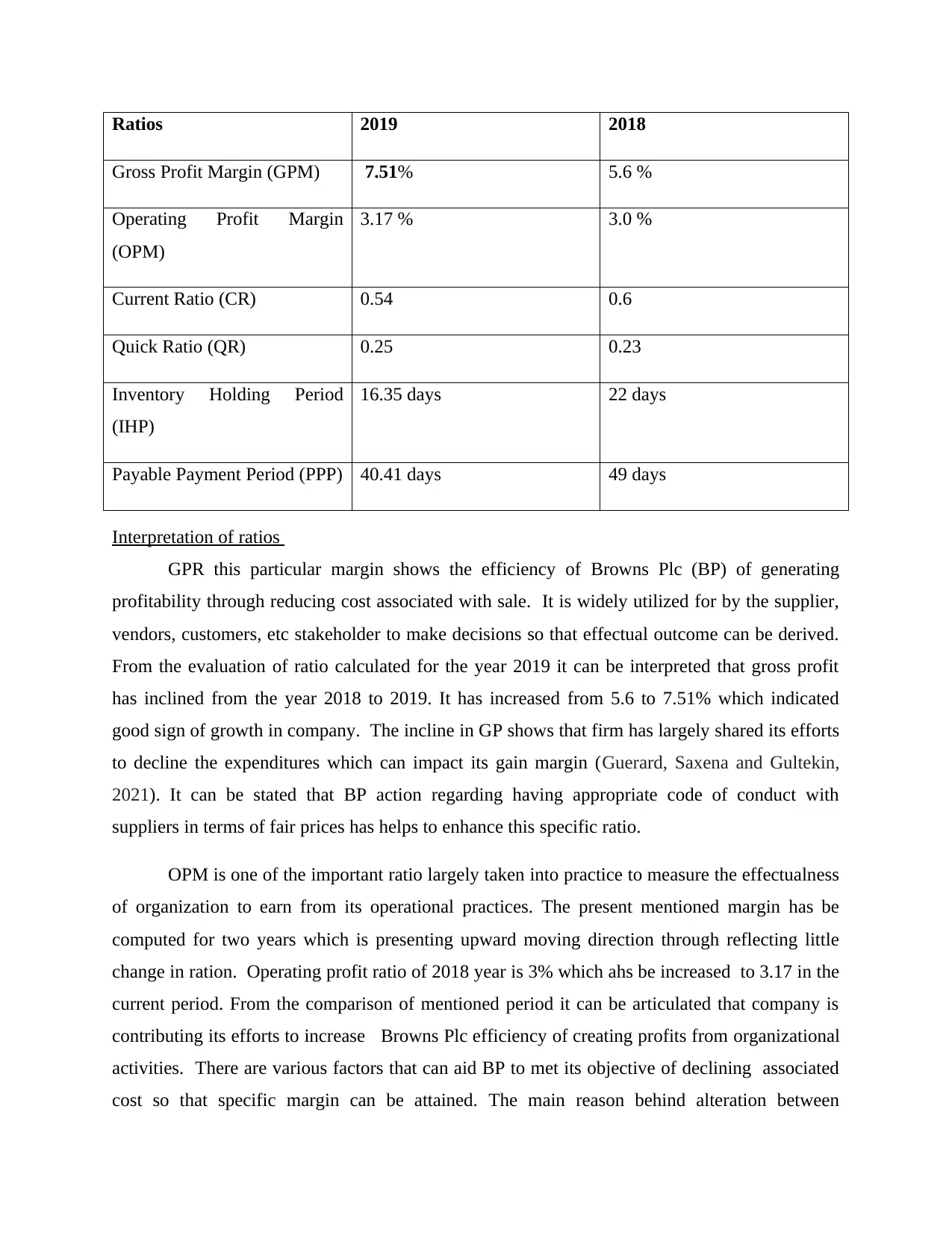
Ratios 2019 2018
Gross Profit Margin (GPM) 7.51% 5.6 %
Operating Profit Margin
(OPM)
3.17 % 3.0 %
Current Ratio (CR) 0.54 0.6
Quick Ratio (QR) 0.25 0.23
Inventory Holding Period
(IHP)
16.35 days 22 days
Payable Payment Period (PPP) 40.41 days 49 days
Interpretation of ratios
GPR this particular margin shows the efficiency of Browns Plc (BP) of generating
profitability through reducing cost associated with sale. It is widely utilized for by the supplier,
vendors, customers, etc stakeholder to make decisions so that effectual outcome can be derived.
From the evaluation of ratio calculated for the year 2019 it can be interpreted that gross profit
has inclined from the year 2018 to 2019. It has increased from 5.6 to 7.51% which indicated
good sign of growth in company. The incline in GP shows that firm has largely shared its efforts
to decline the expenditures which can impact its gain margin (Guerard, Saxena and Gultekin,
2021). It can be stated that BP action regarding having appropriate code of conduct with
suppliers in terms of fair prices has helps to enhance this specific ratio.
OPM is one of the important ratio largely taken into practice to measure the effectualness
of organization to earn from its operational practices. The present mentioned margin has be
computed for two years which is presenting upward moving direction through reflecting little
change in ration. Operating profit ratio of 2018 year is 3% which ahs be increased to 3.17 in the
current period. From the comparison of mentioned period it can be articulated that company is
contributing its efforts to increase Browns Plc efficiency of creating profits from organizational
activities. There are various factors that can aid BP to met its objective of declining associated
cost so that specific margin can be attained. The main reason behind alteration between
Gross Profit Margin (GPM) 7.51% 5.6 %
Operating Profit Margin
(OPM)
3.17 % 3.0 %
Current Ratio (CR) 0.54 0.6
Quick Ratio (QR) 0.25 0.23
Inventory Holding Period
(IHP)
16.35 days 22 days
Payable Payment Period (PPP) 40.41 days 49 days
Interpretation of ratios
GPR this particular margin shows the efficiency of Browns Plc (BP) of generating
profitability through reducing cost associated with sale. It is widely utilized for by the supplier,
vendors, customers, etc stakeholder to make decisions so that effectual outcome can be derived.
From the evaluation of ratio calculated for the year 2019 it can be interpreted that gross profit
has inclined from the year 2018 to 2019. It has increased from 5.6 to 7.51% which indicated
good sign of growth in company. The incline in GP shows that firm has largely shared its efforts
to decline the expenditures which can impact its gain margin (Guerard, Saxena and Gultekin,
2021). It can be stated that BP action regarding having appropriate code of conduct with
suppliers in terms of fair prices has helps to enhance this specific ratio.
OPM is one of the important ratio largely taken into practice to measure the effectualness
of organization to earn from its operational practices. The present mentioned margin has be
computed for two years which is presenting upward moving direction through reflecting little
change in ration. Operating profit ratio of 2018 year is 3% which ahs be increased to 3.17 in the
current period. From the comparison of mentioned period it can be articulated that company is
contributing its efforts to increase Browns Plc efficiency of creating profits from organizational
activities. There are various factors that can aid BP to met its objective of declining associated
cost so that specific margin can be attained. The main reason behind alteration between
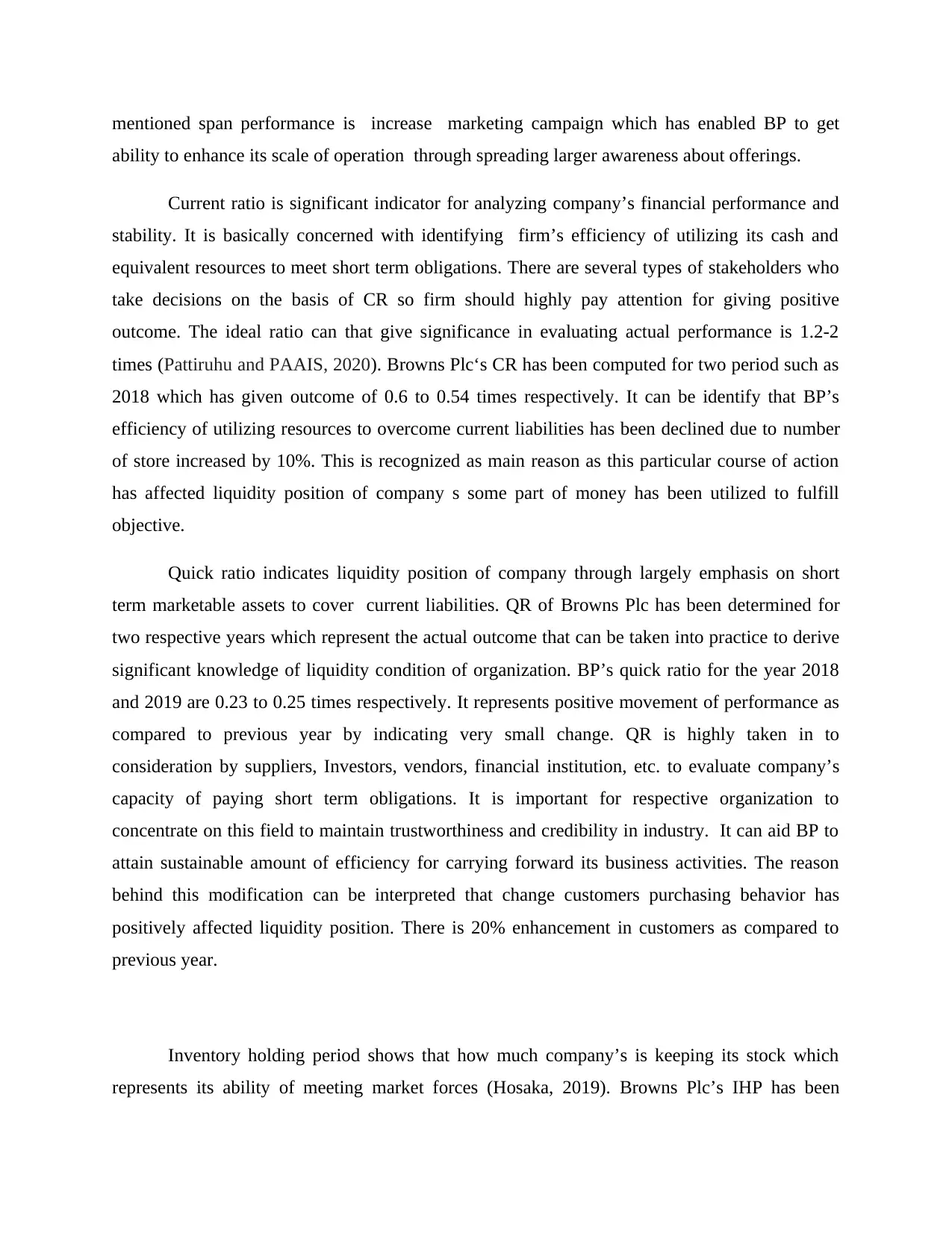
mentioned span performance is increase marketing campaign which has enabled BP to get
ability to enhance its scale of operation through spreading larger awareness about offerings.
Current ratio is significant indicator for analyzing company’s financial performance and
stability. It is basically concerned with identifying firm’s efficiency of utilizing its cash and
equivalent resources to meet short term obligations. There are several types of stakeholders who
take decisions on the basis of CR so firm should highly pay attention for giving positive
outcome. The ideal ratio can that give significance in evaluating actual performance is 1.2-2
times (Pattiruhu and PAAIS, 2020). Browns Plc‘s CR has been computed for two period such as
2018 which has given outcome of 0.6 to 0.54 times respectively. It can be identify that BP’s
efficiency of utilizing resources to overcome current liabilities has been declined due to number
of store increased by 10%. This is recognized as main reason as this particular course of action
has affected liquidity position of company s some part of money has been utilized to fulfill
objective.
Quick ratio indicates liquidity position of company through largely emphasis on short
term marketable assets to cover current liabilities. QR of Browns Plc has been determined for
two respective years which represent the actual outcome that can be taken into practice to derive
significant knowledge of liquidity condition of organization. BP’s quick ratio for the year 2018
and 2019 are 0.23 to 0.25 times respectively. It represents positive movement of performance as
compared to previous year by indicating very small change. QR is highly taken in to
consideration by suppliers, Investors, vendors, financial institution, etc. to evaluate company’s
capacity of paying short term obligations. It is important for respective organization to
concentrate on this field to maintain trustworthiness and credibility in industry. It can aid BP to
attain sustainable amount of efficiency for carrying forward its business activities. The reason
behind this modification can be interpreted that change customers purchasing behavior has
positively affected liquidity position. There is 20% enhancement in customers as compared to
previous year.
Inventory holding period shows that how much company’s is keeping its stock which
represents its ability of meeting market forces (Hosaka, 2019). Browns Plc’s IHP has been
ability to enhance its scale of operation through spreading larger awareness about offerings.
Current ratio is significant indicator for analyzing company’s financial performance and
stability. It is basically concerned with identifying firm’s efficiency of utilizing its cash and
equivalent resources to meet short term obligations. There are several types of stakeholders who
take decisions on the basis of CR so firm should highly pay attention for giving positive
outcome. The ideal ratio can that give significance in evaluating actual performance is 1.2-2
times (Pattiruhu and PAAIS, 2020). Browns Plc‘s CR has been computed for two period such as
2018 which has given outcome of 0.6 to 0.54 times respectively. It can be identify that BP’s
efficiency of utilizing resources to overcome current liabilities has been declined due to number
of store increased by 10%. This is recognized as main reason as this particular course of action
has affected liquidity position of company s some part of money has been utilized to fulfill
objective.
Quick ratio indicates liquidity position of company through largely emphasis on short
term marketable assets to cover current liabilities. QR of Browns Plc has been determined for
two respective years which represent the actual outcome that can be taken into practice to derive
significant knowledge of liquidity condition of organization. BP’s quick ratio for the year 2018
and 2019 are 0.23 to 0.25 times respectively. It represents positive movement of performance as
compared to previous year by indicating very small change. QR is highly taken in to
consideration by suppliers, Investors, vendors, financial institution, etc. to evaluate company’s
capacity of paying short term obligations. It is important for respective organization to
concentrate on this field to maintain trustworthiness and credibility in industry. It can aid BP to
attain sustainable amount of efficiency for carrying forward its business activities. The reason
behind this modification can be interpreted that change customers purchasing behavior has
positively affected liquidity position. There is 20% enhancement in customers as compared to
previous year.
Inventory holding period shows that how much company’s is keeping its stock which
represents its ability of meeting market forces (Hosaka, 2019). Browns Plc’s IHP has been
⊘ This is a preview!⊘
Do you want full access?
Subscribe today to unlock all pages.

Trusted by 1+ million students worldwide

highlighted for mentioned period which helps in comparing current performance with previous.
It can be interpreted that in the year and 2018 & 2019 the respective margin is 22 and
16.35days. The results can be articulated that present year performance has reduced as compared
to earlier period and reason behind this is that company’s online sales has inclined due to higher
marketing campaigns. It has resulted into greater revenue generating capacity as compared to
previous period.
Payable payment period shows company’s ability of paying its debt due to suppliers,
creditors, etc. It is one of the crucial ratios utilized to judge firms’ efficiency of overcoming
liabilities. PPP of 2018 and 2019 are 49 & 40.41 days respectively which is reflecting positive
sign for increasing efficiency of paying debts. The reason behind this action can be long term
borrowing has been utilized to enhance credibility of BP.
Irrelevance of computing the receivables collection period in this case study
There is no scope of credit transaction as Browns Plc’s all operational practices are
conducted in cash manner. The organization’s makes its sales practices in cash manner as there is
involvement of online channels for serving customers. Clients are given option to pay either in
cash or in digital mode of payment so that computation of receivable collection period is
irrelevant. It is calculated when firm conducts sales and offer credit payment option as there is
absence which is main reason for adopted decision.
PART 2 UNDERSTANDING FINANCIAL INFORMATION &
MANAGEMENT OF CASH
2.1 Describing profit & cash flow and differentiation among both
Profit is one of the main objective of any organization for which it implements several
course of actions. It is the amount derived from deducting expenses incurred from the revenue
generated. there are three types of profits which helps business to understand efficiency of
organization in each aspect. In addition to this, it includes gross, operating and net profit.
Profitability is an important measure utilized by several stakeholders like creditors, investors,
financial institutions, etc in order to formulate strategic decision. Greater amount of profit
reflects business has good efficiency in utilizing its resources to generated revenues through
reducing Cost associated with it (What is Profitability? 2021). This provides assistance in
It can be interpreted that in the year and 2018 & 2019 the respective margin is 22 and
16.35days. The results can be articulated that present year performance has reduced as compared
to earlier period and reason behind this is that company’s online sales has inclined due to higher
marketing campaigns. It has resulted into greater revenue generating capacity as compared to
previous period.
Payable payment period shows company’s ability of paying its debt due to suppliers,
creditors, etc. It is one of the crucial ratios utilized to judge firms’ efficiency of overcoming
liabilities. PPP of 2018 and 2019 are 49 & 40.41 days respectively which is reflecting positive
sign for increasing efficiency of paying debts. The reason behind this action can be long term
borrowing has been utilized to enhance credibility of BP.
Irrelevance of computing the receivables collection period in this case study
There is no scope of credit transaction as Browns Plc’s all operational practices are
conducted in cash manner. The organization’s makes its sales practices in cash manner as there is
involvement of online channels for serving customers. Clients are given option to pay either in
cash or in digital mode of payment so that computation of receivable collection period is
irrelevant. It is calculated when firm conducts sales and offer credit payment option as there is
absence which is main reason for adopted decision.
PART 2 UNDERSTANDING FINANCIAL INFORMATION &
MANAGEMENT OF CASH
2.1 Describing profit & cash flow and differentiation among both
Profit is one of the main objective of any organization for which it implements several
course of actions. It is the amount derived from deducting expenses incurred from the revenue
generated. there are three types of profits which helps business to understand efficiency of
organization in each aspect. In addition to this, it includes gross, operating and net profit.
Profitability is an important measure utilized by several stakeholders like creditors, investors,
financial institutions, etc in order to formulate strategic decision. Greater amount of profit
reflects business has good efficiency in utilizing its resources to generated revenues through
reducing Cost associated with it (What is Profitability? 2021). This provides assistance in
Paraphrase This Document
Need a fresh take? Get an instant paraphrase of this document with our AI Paraphraser
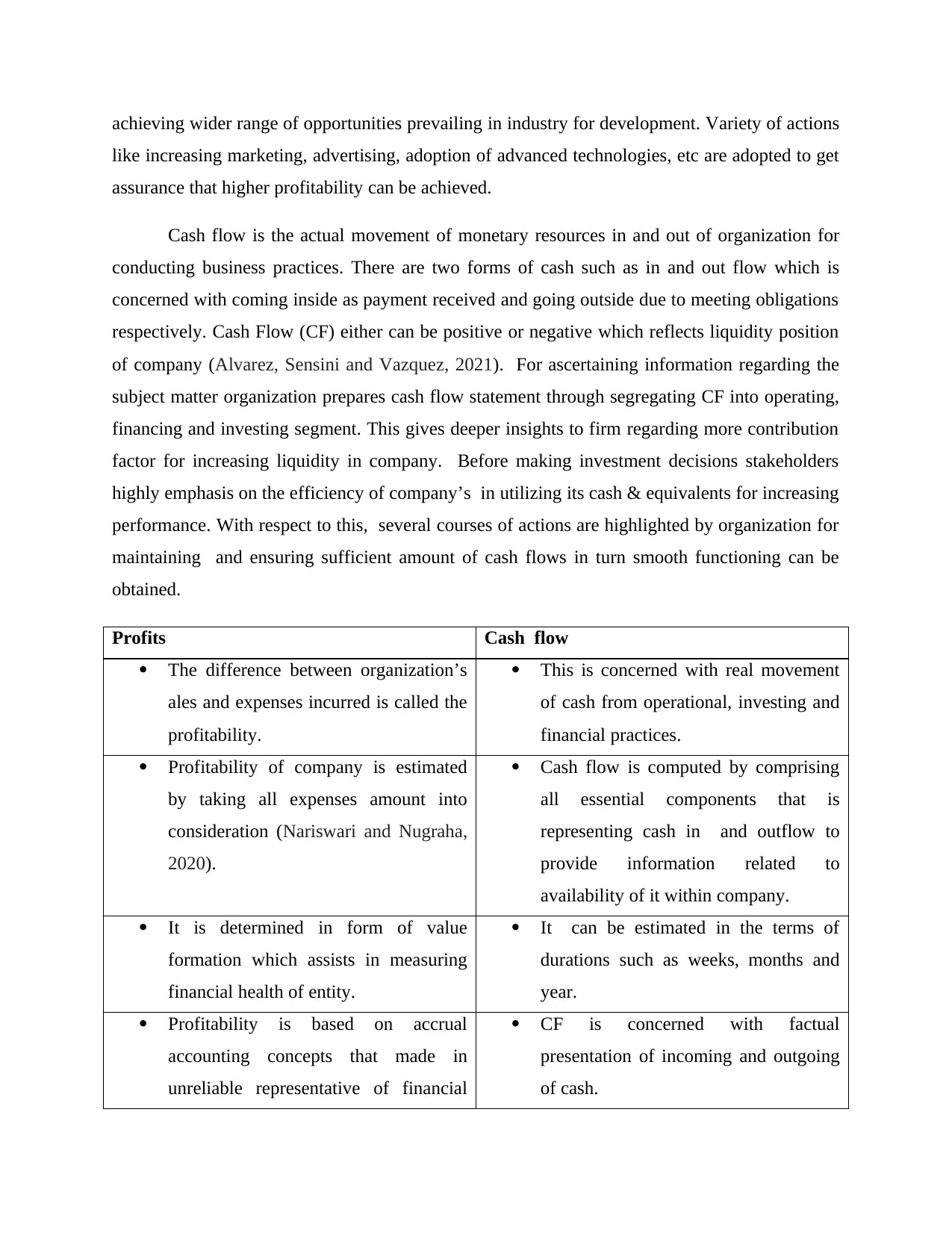
achieving wider range of opportunities prevailing in industry for development. Variety of actions
like increasing marketing, advertising, adoption of advanced technologies, etc are adopted to get
assurance that higher profitability can be achieved.
Cash flow is the actual movement of monetary resources in and out of organization for
conducting business practices. There are two forms of cash such as in and out flow which is
concerned with coming inside as payment received and going outside due to meeting obligations
respectively. Cash Flow (CF) either can be positive or negative which reflects liquidity position
of company (Alvarez, Sensini and Vazquez, 2021). For ascertaining information regarding the
subject matter organization prepares cash flow statement through segregating CF into operating,
financing and investing segment. This gives deeper insights to firm regarding more contribution
factor for increasing liquidity in company. Before making investment decisions stakeholders
highly emphasis on the efficiency of company’s in utilizing its cash & equivalents for increasing
performance. With respect to this, several courses of actions are highlighted by organization for
maintaining and ensuring sufficient amount of cash flows in turn smooth functioning can be
obtained.
Profits Cash flow
The difference between organization’s
ales and expenses incurred is called the
profitability.
This is concerned with real movement
of cash from operational, investing and
financial practices.
Profitability of company is estimated
by taking all expenses amount into
consideration (Nariswari and Nugraha,
2020).
Cash flow is computed by comprising
all essential components that is
representing cash in and outflow to
provide information related to
availability of it within company.
It is determined in form of value
formation which assists in measuring
financial health of entity.
It can be estimated in the terms of
durations such as weeks, months and
year.
Profitability is based on accrual
accounting concepts that made in
unreliable representative of financial
CF is concerned with factual
presentation of incoming and outgoing
of cash.
like increasing marketing, advertising, adoption of advanced technologies, etc are adopted to get
assurance that higher profitability can be achieved.
Cash flow is the actual movement of monetary resources in and out of organization for
conducting business practices. There are two forms of cash such as in and out flow which is
concerned with coming inside as payment received and going outside due to meeting obligations
respectively. Cash Flow (CF) either can be positive or negative which reflects liquidity position
of company (Alvarez, Sensini and Vazquez, 2021). For ascertaining information regarding the
subject matter organization prepares cash flow statement through segregating CF into operating,
financing and investing segment. This gives deeper insights to firm regarding more contribution
factor for increasing liquidity in company. Before making investment decisions stakeholders
highly emphasis on the efficiency of company’s in utilizing its cash & equivalents for increasing
performance. With respect to this, several courses of actions are highlighted by organization for
maintaining and ensuring sufficient amount of cash flows in turn smooth functioning can be
obtained.
Profits Cash flow
The difference between organization’s
ales and expenses incurred is called the
profitability.
This is concerned with real movement
of cash from operational, investing and
financial practices.
Profitability of company is estimated
by taking all expenses amount into
consideration (Nariswari and Nugraha,
2020).
Cash flow is computed by comprising
all essential components that is
representing cash in and outflow to
provide information related to
availability of it within company.
It is determined in form of value
formation which assists in measuring
financial health of entity.
It can be estimated in the terms of
durations such as weeks, months and
year.
Profitability is based on accrual
accounting concepts that made in
unreliable representative of financial
CF is concerned with factual
presentation of incoming and outgoing
of cash.
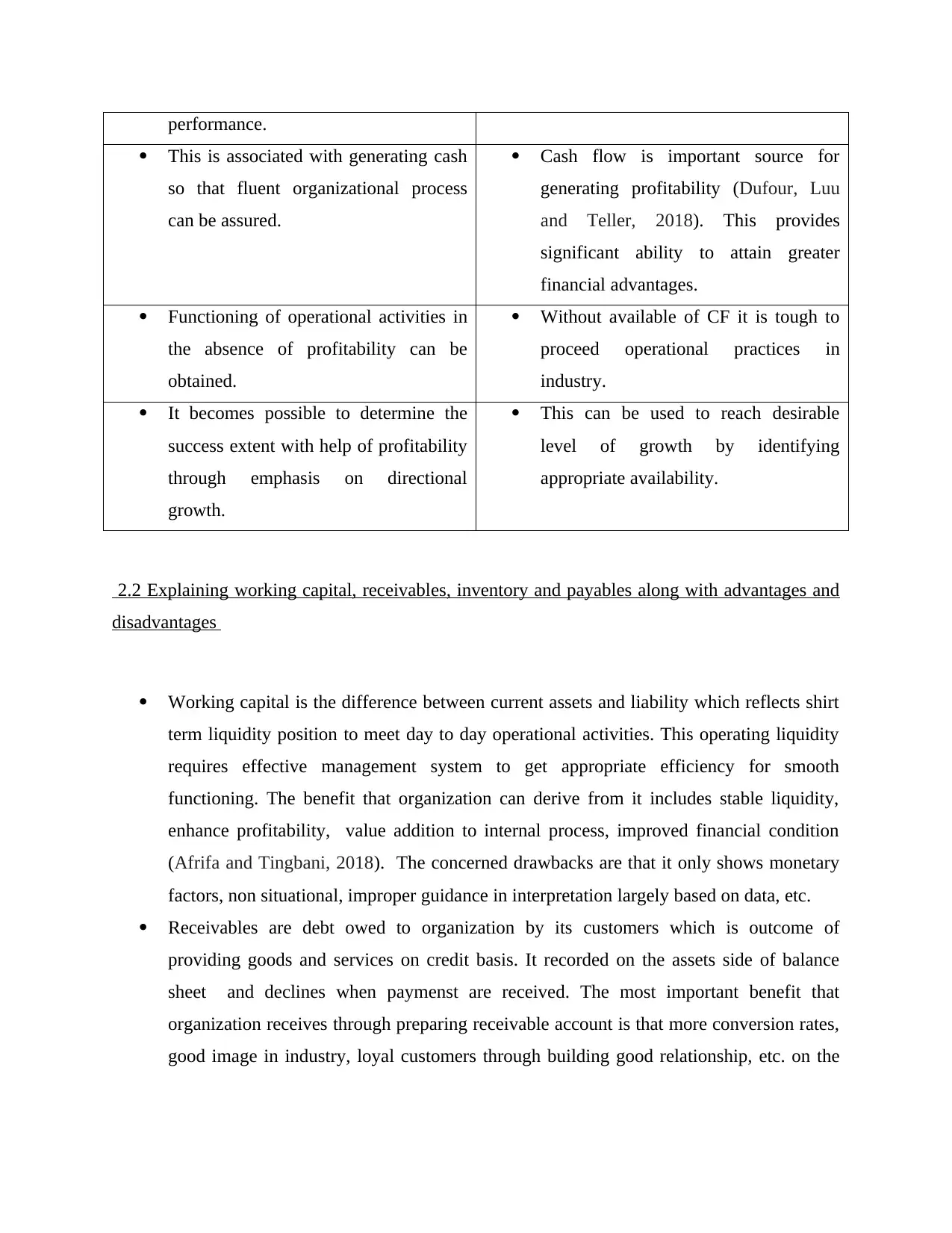
performance.
This is associated with generating cash
so that fluent organizational process
can be assured.
Cash flow is important source for
generating profitability (Dufour, Luu
and Teller, 2018). This provides
significant ability to attain greater
financial advantages.
Functioning of operational activities in
the absence of profitability can be
obtained.
Without available of CF it is tough to
proceed operational practices in
industry.
It becomes possible to determine the
success extent with help of profitability
through emphasis on directional
growth.
This can be used to reach desirable
level of growth by identifying
appropriate availability.
2.2 Explaining working capital, receivables, inventory and payables along with advantages and
disadvantages
Working capital is the difference between current assets and liability which reflects shirt
term liquidity position to meet day to day operational activities. This operating liquidity
requires effective management system to get appropriate efficiency for smooth
functioning. The benefit that organization can derive from it includes stable liquidity,
enhance profitability, value addition to internal process, improved financial condition
(Afrifa and Tingbani, 2018). The concerned drawbacks are that it only shows monetary
factors, non situational, improper guidance in interpretation largely based on data, etc.
Receivables are debt owed to organization by its customers which is outcome of
providing goods and services on credit basis. It recorded on the assets side of balance
sheet and declines when paymenst are received. The most important benefit that
organization receives through preparing receivable account is that more conversion rates,
good image in industry, loyal customers through building good relationship, etc. on the
This is associated with generating cash
so that fluent organizational process
can be assured.
Cash flow is important source for
generating profitability (Dufour, Luu
and Teller, 2018). This provides
significant ability to attain greater
financial advantages.
Functioning of operational activities in
the absence of profitability can be
obtained.
Without available of CF it is tough to
proceed operational practices in
industry.
It becomes possible to determine the
success extent with help of profitability
through emphasis on directional
growth.
This can be used to reach desirable
level of growth by identifying
appropriate availability.
2.2 Explaining working capital, receivables, inventory and payables along with advantages and
disadvantages
Working capital is the difference between current assets and liability which reflects shirt
term liquidity position to meet day to day operational activities. This operating liquidity
requires effective management system to get appropriate efficiency for smooth
functioning. The benefit that organization can derive from it includes stable liquidity,
enhance profitability, value addition to internal process, improved financial condition
(Afrifa and Tingbani, 2018). The concerned drawbacks are that it only shows monetary
factors, non situational, improper guidance in interpretation largely based on data, etc.
Receivables are debt owed to organization by its customers which is outcome of
providing goods and services on credit basis. It recorded on the assets side of balance
sheet and declines when paymenst are received. The most important benefit that
organization receives through preparing receivable account is that more conversion rates,
good image in industry, loyal customers through building good relationship, etc. on the
⊘ This is a preview!⊘
Do you want full access?
Subscribe today to unlock all pages.

Trusted by 1+ million students worldwide

other side limitation of having receivables are that there is no guarantee of payment
recovery as possibility of bad debt, more time consuming, etc.
Inventory refers to availability of stock regarding finished goods, work in process and
raw material. It helps in obtaining ability to meet market forces which is biggest
advantage. The limitation of it is relatively expensive to have manage due to complex
nature.
Payables are the amount due to pay by company to its suppliers, vendors, etc. which
reflects credibility in industry. Having effective payment payable period helps in raising
funds with lower span of time and gaining trustworthiness among stakeholders. It is
recorded in balance sheet in the head of current liabilities and decreases as payments are
made. Pros of payables are availability of time to manage expenses in order to pay in
organized manner. The cons are that burden is created on suppliers that may harm the
efficiency of organization’s procurement procedure.
2.3 Explaining the reasons for changes in working capital affecting cash flow
These two are most crucial concept of financial analysis so gaining significant knowledge
respect to changes become important. Cash flow statement is widely prepared by organization
irrespective of their scale of operation. Cash is part of current assets that is significant factor for
determining working capital. The changes in any part of current assets or liability impact cash
flow in positive or negative factor. If there is alteration in same proportion then there will no
influence on CF. There are several types of actions taken by firm to reduce negative impact of
WC on cash flow (What is net working capital? 2021). In addition to this, direct and indirect
methods for computing correct balance is utilized in turn depth understanding regarding the same
can be obtained. For instance if the firm is selling fixed assets which means that cash will come
in company that represents growth in current assets. Alteration in working capital will highly
influence the cash flow in positive manner. This reflects that company has good financial health
in terms of liquidity.
Several types of business transaction take place which impacts on working capital as if there is
inclination of current assets then can be interpreted there would be enhance in cash flow of
company in order to maintain sustainable operational practices. If there is increase in liabilities
then it will influence working capital by declining cash flow available with company.
recovery as possibility of bad debt, more time consuming, etc.
Inventory refers to availability of stock regarding finished goods, work in process and
raw material. It helps in obtaining ability to meet market forces which is biggest
advantage. The limitation of it is relatively expensive to have manage due to complex
nature.
Payables are the amount due to pay by company to its suppliers, vendors, etc. which
reflects credibility in industry. Having effective payment payable period helps in raising
funds with lower span of time and gaining trustworthiness among stakeholders. It is
recorded in balance sheet in the head of current liabilities and decreases as payments are
made. Pros of payables are availability of time to manage expenses in order to pay in
organized manner. The cons are that burden is created on suppliers that may harm the
efficiency of organization’s procurement procedure.
2.3 Explaining the reasons for changes in working capital affecting cash flow
These two are most crucial concept of financial analysis so gaining significant knowledge
respect to changes become important. Cash flow statement is widely prepared by organization
irrespective of their scale of operation. Cash is part of current assets that is significant factor for
determining working capital. The changes in any part of current assets or liability impact cash
flow in positive or negative factor. If there is alteration in same proportion then there will no
influence on CF. There are several types of actions taken by firm to reduce negative impact of
WC on cash flow (What is net working capital? 2021). In addition to this, direct and indirect
methods for computing correct balance is utilized in turn depth understanding regarding the same
can be obtained. For instance if the firm is selling fixed assets which means that cash will come
in company that represents growth in current assets. Alteration in working capital will highly
influence the cash flow in positive manner. This reflects that company has good financial health
in terms of liquidity.
Several types of business transaction take place which impacts on working capital as if there is
inclination of current assets then can be interpreted there would be enhance in cash flow of
company in order to maintain sustainable operational practices. If there is increase in liabilities
then it will influence working capital by declining cash flow available with company.
Paraphrase This Document
Need a fresh take? Get an instant paraphrase of this document with our AI Paraphraser
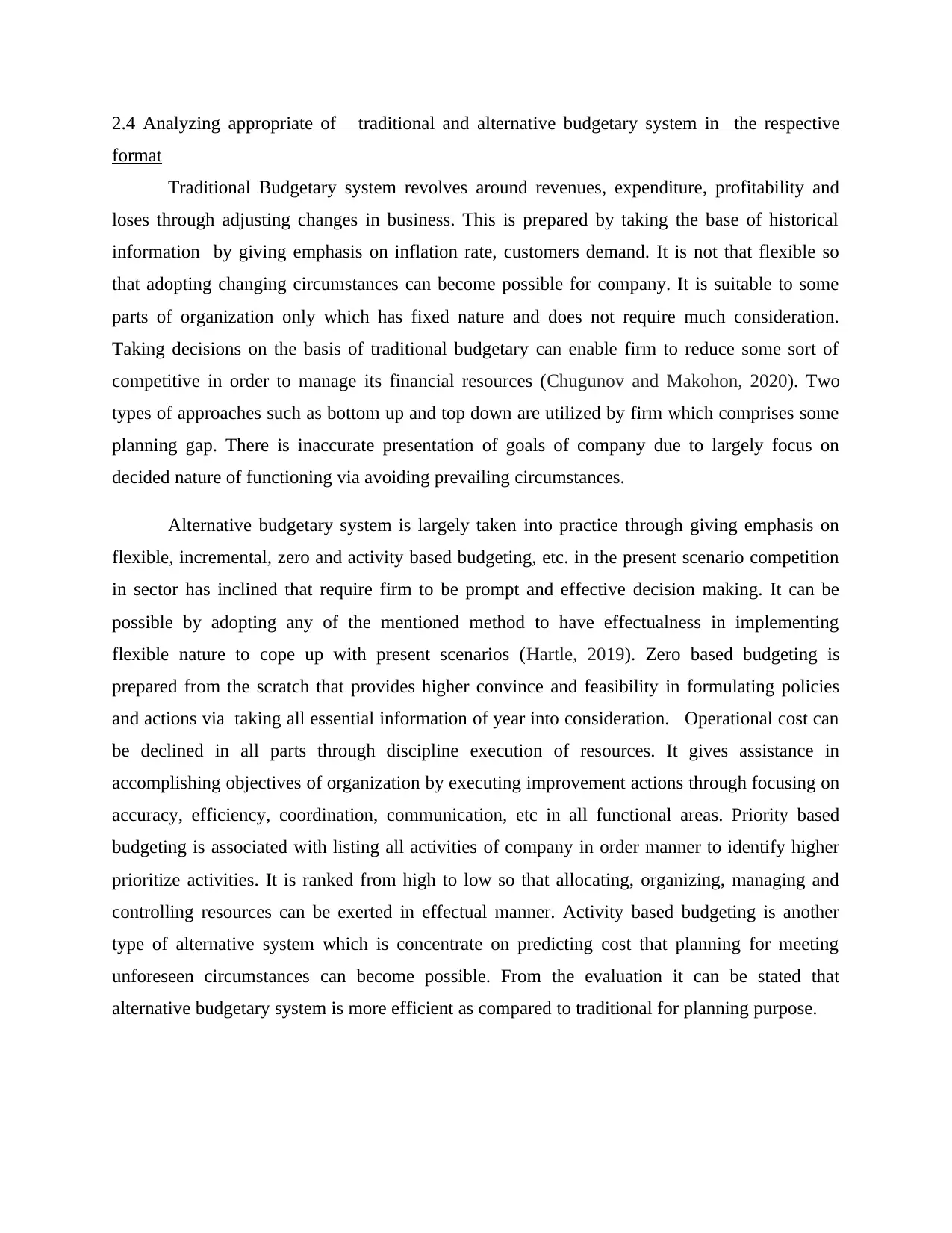
2.4 Analyzing appropriate of traditional and alternative budgetary system in the respective
format
Traditional Budgetary system revolves around revenues, expenditure, profitability and
loses through adjusting changes in business. This is prepared by taking the base of historical
information by giving emphasis on inflation rate, customers demand. It is not that flexible so
that adopting changing circumstances can become possible for company. It is suitable to some
parts of organization only which has fixed nature and does not require much consideration.
Taking decisions on the basis of traditional budgetary can enable firm to reduce some sort of
competitive in order to manage its financial resources (Chugunov and Makohon, 2020). Two
types of approaches such as bottom up and top down are utilized by firm which comprises some
planning gap. There is inaccurate presentation of goals of company due to largely focus on
decided nature of functioning via avoiding prevailing circumstances.
Alternative budgetary system is largely taken into practice through giving emphasis on
flexible, incremental, zero and activity based budgeting, etc. in the present scenario competition
in sector has inclined that require firm to be prompt and effective decision making. It can be
possible by adopting any of the mentioned method to have effectualness in implementing
flexible nature to cope up with present scenarios (Hartle, 2019). Zero based budgeting is
prepared from the scratch that provides higher convince and feasibility in formulating policies
and actions via taking all essential information of year into consideration. Operational cost can
be declined in all parts through discipline execution of resources. It gives assistance in
accomplishing objectives of organization by executing improvement actions through focusing on
accuracy, efficiency, coordination, communication, etc in all functional areas. Priority based
budgeting is associated with listing all activities of company in order manner to identify higher
prioritize activities. It is ranked from high to low so that allocating, organizing, managing and
controlling resources can be exerted in effectual manner. Activity based budgeting is another
type of alternative system which is concentrate on predicting cost that planning for meeting
unforeseen circumstances can become possible. From the evaluation it can be stated that
alternative budgetary system is more efficient as compared to traditional for planning purpose.
format
Traditional Budgetary system revolves around revenues, expenditure, profitability and
loses through adjusting changes in business. This is prepared by taking the base of historical
information by giving emphasis on inflation rate, customers demand. It is not that flexible so
that adopting changing circumstances can become possible for company. It is suitable to some
parts of organization only which has fixed nature and does not require much consideration.
Taking decisions on the basis of traditional budgetary can enable firm to reduce some sort of
competitive in order to manage its financial resources (Chugunov and Makohon, 2020). Two
types of approaches such as bottom up and top down are utilized by firm which comprises some
planning gap. There is inaccurate presentation of goals of company due to largely focus on
decided nature of functioning via avoiding prevailing circumstances.
Alternative budgetary system is largely taken into practice through giving emphasis on
flexible, incremental, zero and activity based budgeting, etc. in the present scenario competition
in sector has inclined that require firm to be prompt and effective decision making. It can be
possible by adopting any of the mentioned method to have effectualness in implementing
flexible nature to cope up with present scenarios (Hartle, 2019). Zero based budgeting is
prepared from the scratch that provides higher convince and feasibility in formulating policies
and actions via taking all essential information of year into consideration. Operational cost can
be declined in all parts through discipline execution of resources. It gives assistance in
accomplishing objectives of organization by executing improvement actions through focusing on
accuracy, efficiency, coordination, communication, etc in all functional areas. Priority based
budgeting is associated with listing all activities of company in order manner to identify higher
prioritize activities. It is ranked from high to low so that allocating, organizing, managing and
controlling resources can be exerted in effectual manner. Activity based budgeting is another
type of alternative system which is concentrate on predicting cost that planning for meeting
unforeseen circumstances can become possible. From the evaluation it can be stated that
alternative budgetary system is more efficient as compared to traditional for planning purpose.
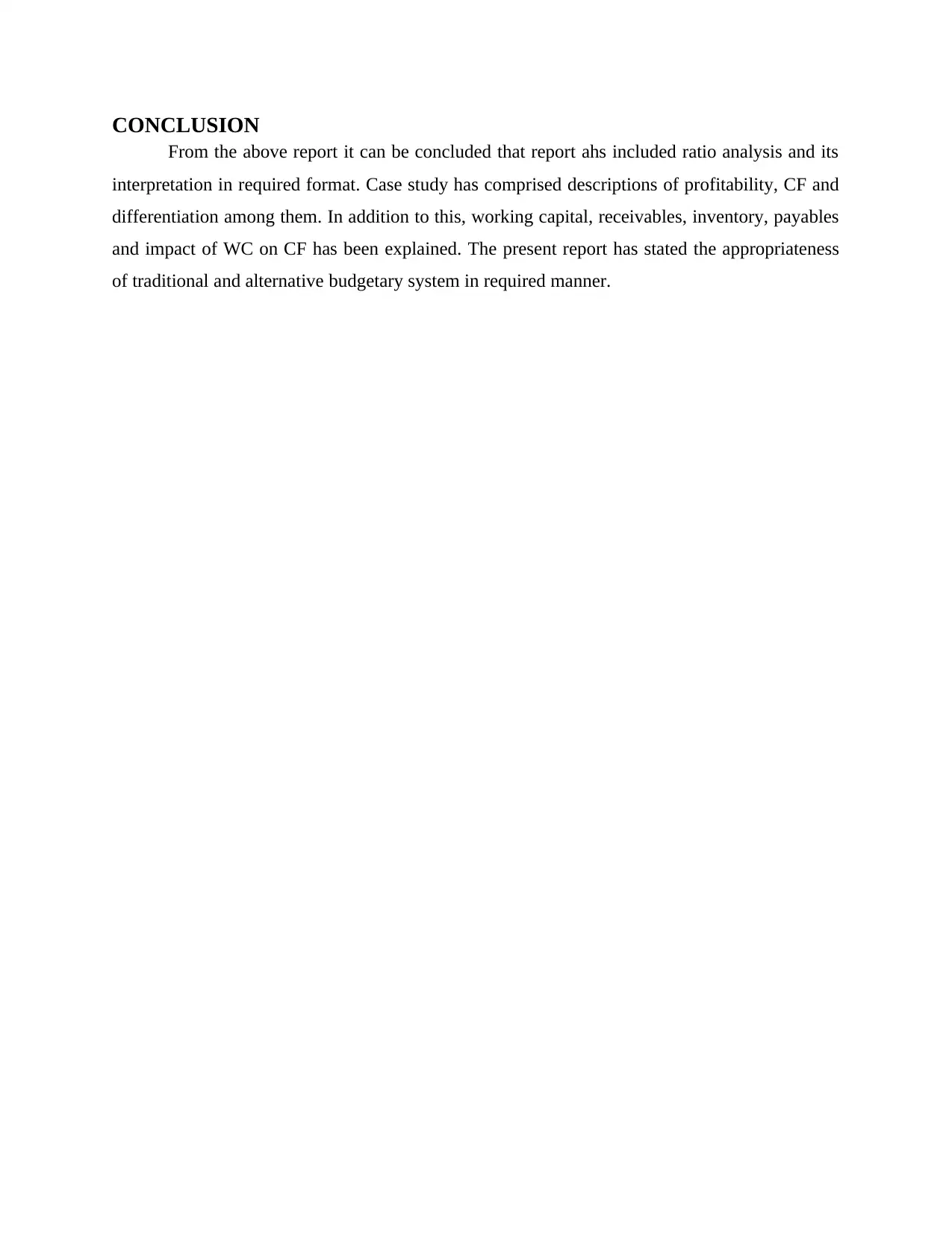
CONCLUSION
From the above report it can be concluded that report ahs included ratio analysis and its
interpretation in required format. Case study has comprised descriptions of profitability, CF and
differentiation among them. In addition to this, working capital, receivables, inventory, payables
and impact of WC on CF has been explained. The present report has stated the appropriateness
of traditional and alternative budgetary system in required manner.
From the above report it can be concluded that report ahs included ratio analysis and its
interpretation in required format. Case study has comprised descriptions of profitability, CF and
differentiation among them. In addition to this, working capital, receivables, inventory, payables
and impact of WC on CF has been explained. The present report has stated the appropriateness
of traditional and alternative budgetary system in required manner.
⊘ This is a preview!⊘
Do you want full access?
Subscribe today to unlock all pages.

Trusted by 1+ million students worldwide
1 out of 13
Related Documents
Your All-in-One AI-Powered Toolkit for Academic Success.
+13062052269
info@desklib.com
Available 24*7 on WhatsApp / Email
![[object Object]](/_next/static/media/star-bottom.7253800d.svg)
Unlock your academic potential
Copyright © 2020–2026 A2Z Services. All Rights Reserved. Developed and managed by ZUCOL.





